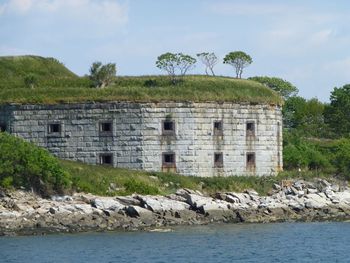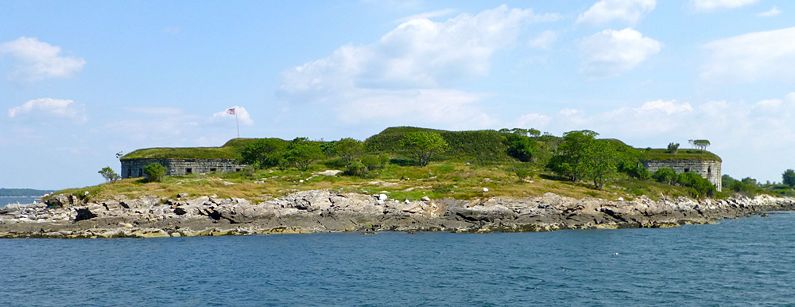Fort Scammel
|
Fort Scammel (1808-1898) - Established 1808 on House Island in Portland Harbor, Cumberland County, Maine. Built as a Second System Fort by Henry Alexander Scammell Dearborn and rebuilt as a Third System Fort by then Captain Thomas Lincoln Casey in 1862. Named after Colonel Alexander Scammel, Adjutant general of the Continental Army during the Revolutionary War, who was killed during the Siege of Yorktown. Also known as Fort Scammell.
Second System (1808-1816)Part of the Harbor Defense of Portland, Maine. 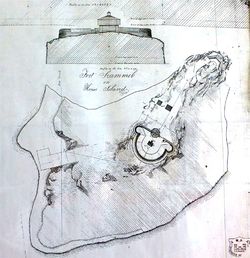 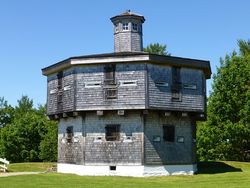 Designed as a Second System fortification for the harbor defense of Portland, Maine. It was built under the direction of Henry Alexander Scammell Dearborn who was the son of the Secretary of War. Dearborn also oversaw the construction of nearby Fort Preble. Fort Scammel was built as a semi-circular fortification facing Casco Bay and the entrance to Portland Harbor. Like many of the Second System forts, Fort Scammel had a large, octaginal blockhouse built from heavy timbers with guns on the upper floor. The blockhouse was located at the rear of fortification, at the center was a powder magazine and a shot furnace. The fort and the blockhouse were painted white so that all would know that the port was defended (see Fort Edgecomb for a blockhouse example). At the top of the blockhouse was a large carved wooden eagle. The original fort had emplacements for eleven 24 and 32-pounder cannons and several more guns on a separate battery on the east side of the island. In the 1840s and 1850s the walls of the original semi-circular fortification were extended on the right and left flanks and finally to the rear to fully enclose a much larger area. This new configuration provided a land side defense as well as covering the approaches to Portland Harbor.
U.S. Civil War (1861-1865) 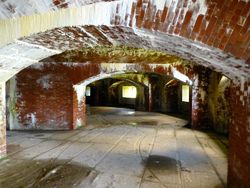 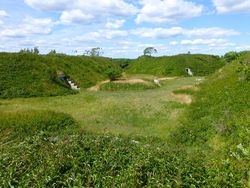 During the U.S. Civil War Fort Scammel was expanded and rebuilt as a Third System fort. The major changes included stone bastions on the east and west side of the island and major earthwork connecting the two bastions. A planned north bastion was never completed. The rebuilt Fort Scammel was to have mounted 71 guns including seven mortars but was never fully armed or garrisoned. In 1862 the east and west bastions were begun as Third System stone and brick works. The bastions were both designed to be open at the rear with stone casemates facing Casco Bay. The west bastion was designed with two levels of casemates while the east bastion was designed to have three levels of casemates. The bastions were almost stand alone fortifications connected on the south side by the original fort walls and extensions. The east bastion was completed to the second level of casemates and included a spiral staircase to the upper level. The west bastion was completed only to the first level. Work on the fort continued after the U.S. Civil War and modifications were completed to allow the mounting of 10" and 15" Rodman guns and for larger concrete magazines required by these huge guns. The shift in construction materials can be seen inside the east bastion where stone, brick and concrete structures are evident. At some point in the upgrade process the casemates were completely enclosed using vaulted concrete ceilings over formerly open spaces. Tunnels were built to connect the bastions to the parade and to the network of six large magazines that lined the parade. The parade was reduced in size and leveled so that the big guns lining the parapets could be serviced from the magazines. Along the southeast side of the parade and over the site of the original blockhouse a great central magazine was built to service the large guns. The funding freeze for coastal defense projects in the latter half of the 1870s stopped modification work at Fort Scammel and a planned battery on the north end was never completed. The unfinished walls can be seen along the north side. By 1903 the fort was listed as without armament and "Not garrisoned. A completed work of the old type. Magazines dry with one exception. Woodwork decayed. In place scarp wall has separated from body of work; otherwise in good condition". Two 3" anti-aircraft gun emplacements were built on the parapets circa 1917 but it is not known if the guns were actually emplaced. House island was also the site of a U.S. Immigration Quarantine Station from 1907 to 1937.
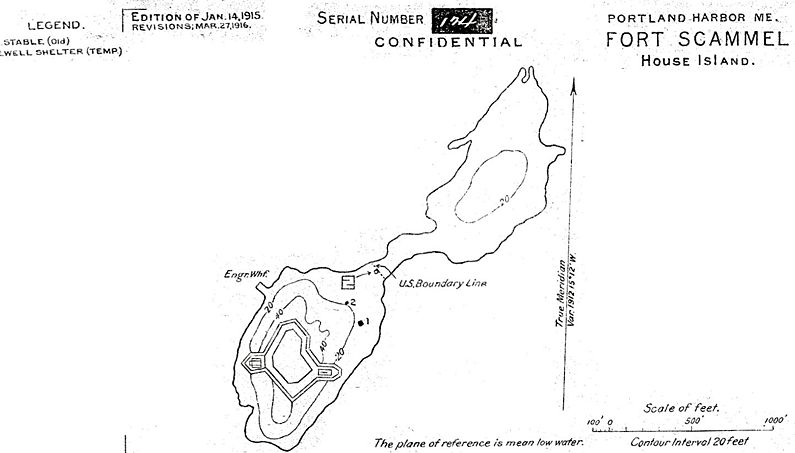
Current Status In addition to the fort, three houses still occupy the island. All three were built for U.S. Immigration Quarantine Station in 1907 and include the doctor's house, the administration building, and the quarantine hospital. The Island, the fort and the buildings are owned by a private party and are currently offered for sale for $4.5 million dollars. Tours of the fort are conducted during the summer season from Long Pier on the Portland Waterfront. The tour includes a comprehensive tour of the east bastion and a walk across the southeast parapet. For more information, check the website.
Sources:
Links:
Visited: 3 Jul 2012 Picture Gallery
| ||||||
